It seems that days and weeks really flies lately and I don't have enough time to write about all the breads I bake. To get upto date, I'll make a resume with the most important breads I've baked in the last days/week:
1. I made semolina bread, in two different days (first it was a 60% semolina + 40% white flour with 67% hydration, next time it was a 70% semolina + 30% white flour and 71% hydration), inspiread by Hamelman's Semolina Bread and Giovanni's bread. I used a stiff levain and I had to add a lot of water to the dough, and I still think it was not enough. But semolina bread is one of my latest revelations, I love it's flavor so much... too bad I have only one bag of semolina left... :(


The crumb is yellow, but not as opened as it i in giovanni's bread, yet, it is a very tasty formula. It's elastic and chewy and it's wonderful sweet when toasted.
Here are pictures from the first bread:
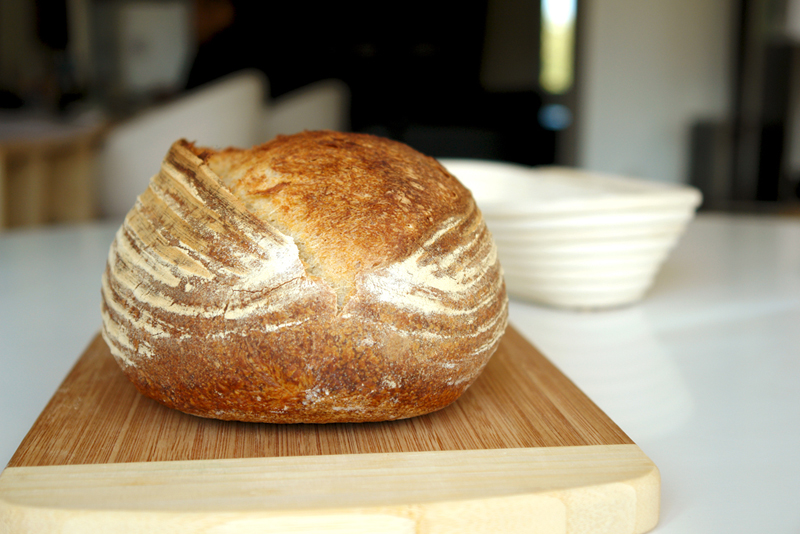
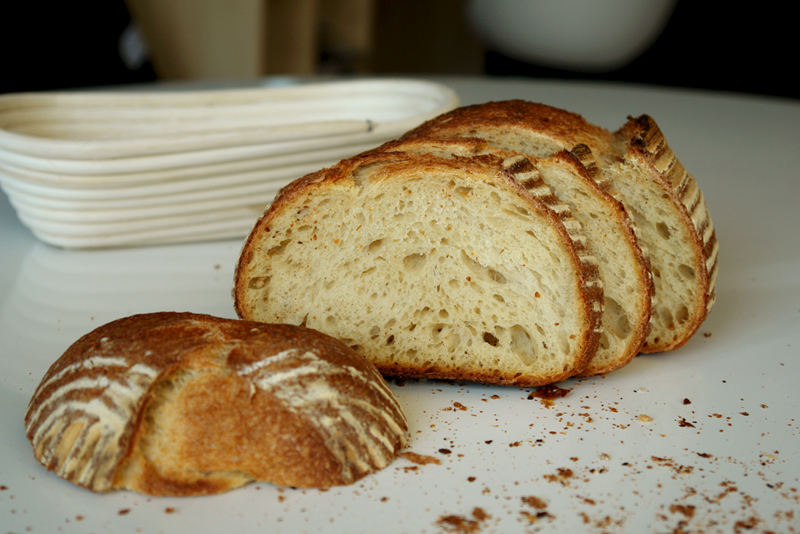
And from the second one: (I dind't realise before how much they resemble, till I put the pictures together)

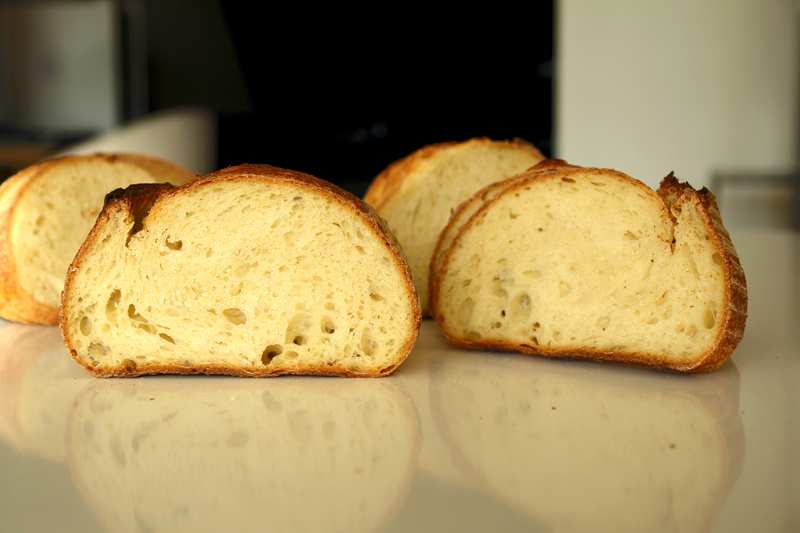
2. I make baguettes again, using the same formula as the last time, reducing the hydration to 71%. Better than the first time, but still a long way from perfection.

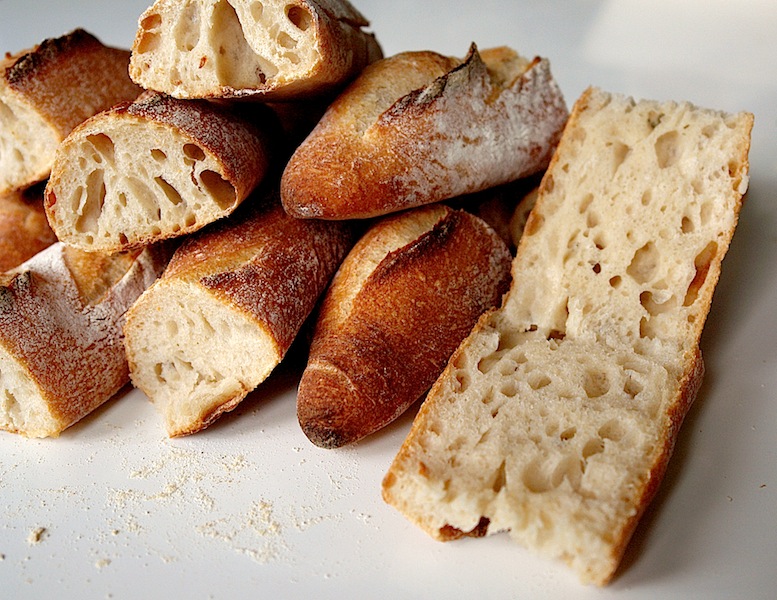
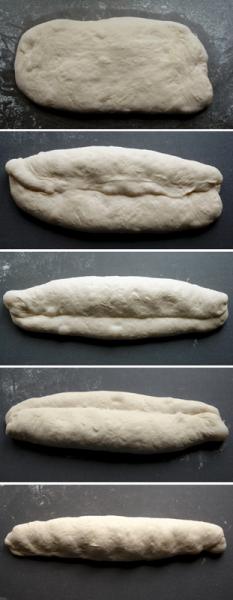
3. I made another rye bread, using a rye soaker and rye chops made from soaked berries, chopped and then soaked again. I started with 90g berries (140g after soaking and draining) and ended with 210g rye chops, soaked and drained.

The bread has more volume than the last time, even if the dough got stucked in the banneton in a couple of places and it deflated a bit while I forced it to come out. (mini, I did not cheat while I sliced the bread, no funny angles while cutting it, and I have 8-9 cm max... well it's better than 6 cm from last time:)

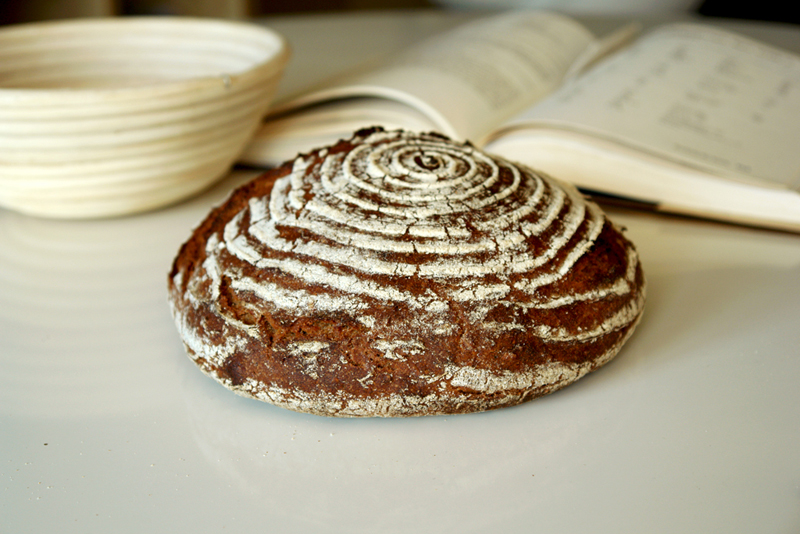
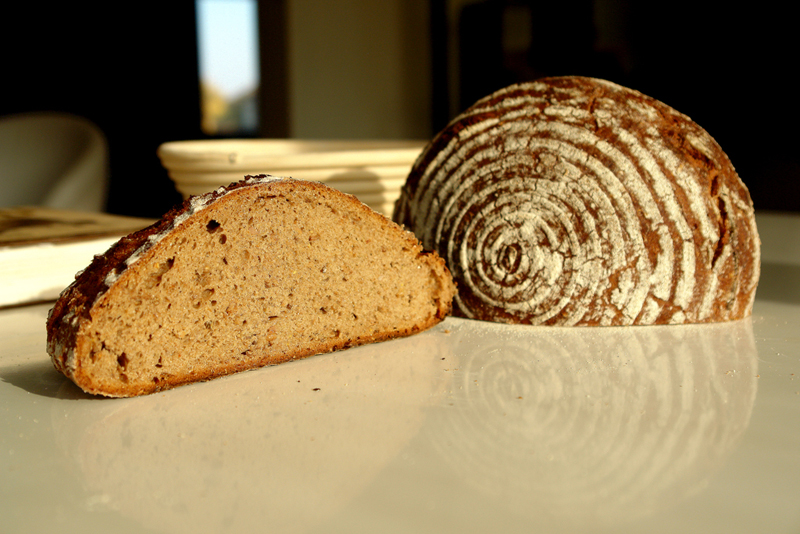


The bigger holes in the crumb are a sign of overproofing, or a sign of air or/and water incorporated in the dough while shaping?
Well, that's about it, for now. Not quite up-to-date, I still have some "san joaquin"s left that I want share with you, but this is already a too long post.
codruta
- codruta's Blog
- Log in or register to post comments
Codruta, you made excellent use of your semolina, the bread is outstanding!
Very lovely rye, too, even better than the former bread in my opinion.
How finely milled is your semolina? Is it still the De Cecco?
Hi, Nico. thank you for your words. After falling in love with rye bread, I discovered the taste of semolina and for a week, I was in heaven. I couldn't decide what to eat for breakfast, so I ate both of them, everyday. I can almost cry thinking that in a short time I won't have semolina flour. :(((
Yes, is the same De Cecco rimacinatta, I never tried or tasted another.
I still have problems with shaping rye dough, this last time I "worked" the dough for almost five minutes, just moving it from one hand to another, wetting my hands, it was very stressful, wandering if I'm doing it right, and not knowing how to transfer it from my hands in the banneton. Finally I dropped it, and a cloud of flour flied from the banneton on the working table. I think that was the moment the dough stucked... Working with rye dough remains a mistery for me, and excercises a strange fascination on my mind.
codruta
Codruta,
I can understand your worry not having semolina around - your breads have some addictive qualities ...
Your rye looks lovely as well. Maybe when shaping rye it helps to remember you are not stretching gluten sheets?
All you need to get is a smooth surface (that's my opinion, anyway).
Juergen
Juergen,
I'm doing my best to work with rye dough, but it is still an unfamiliar teritory. I'm sure you're right: I have to remember that rye is completely diferent than wheat, and though in my head I understand that, my hands don't seem to know what to do with that sticky paste. "all you need to get is a smooth surface"- that is a very good advise: I'll keep that in mind next time.
Thank you for your compliments and advises.
codruta
Could you tell us what you used to chop your rye berries? Patsy
Hi, Patsy. You have to soak the berries overnight, then to drain them. Then use a very big sharp knife and chop them on a hard board (like you would mince garlic, or parsley leaves). Keep one hand on the blade for guiding, and one hand on the handle. (I have experience with chopping and mincing and I can move very fast the knife, but if you think it is not safe... don't do it, I don't want you to get hurt)
Be safe,
Codruta
For that idea. I'm always glad to hear about something that I don't have to buy new equipment for! Patsy
Codruta, I almost didn't open your post because seeing your breads makes me feel envious of your skills. I too have a fascination with rye breads but so far have not attempted anything beyond a 30-40% rye loaf. The semolina looks delicious. I have some semolina flour and will have to try it. I much prefer dark flours, under the (perhaps mistaken) assumption that they are more healthful and flavorful. Someday I am going to attempt a Pumpernickel.
I have 2 questions. 1. I use a razor blade and a coffee stick too, but I use a single edge razor fastented to the stick with a little clip, so it is straight. What is the advantage of using a curved blade?
2. You seem to bake so much bread - to whom do you give it? I live with just my husband, and although I have a few friends I give bread to and twice a month have groups I can give 16 baguettes to, I still wish to bake more breads, with more variety, than I do now.
Also, your pictures of the baguette shaping are very helpful.
Thanks!
Sue
Thank you Sue. Please don't feel envious, I worked very hard to get here, and I'm never satisfied, I always want to learn more. Behind what you see is a lot of reading and documentation before trying a new bread, some failures along the way, and a strong determination to never give up.
Pumpernickel is on my list too, and I also usually prefer dark flours, but when a bread is that good as this semolina bread, it really doesn't matter if is dark or light. :)
1. I use a curved blade for breads (usually lean, white doughs) that I want to have a "ear". The blade is held in an angled position, almost parallel with the surface of the dough. I use a straight blade for whole wheat breads that have a denser crumb and won't develop a grigne (ear). For these you have to keep the blade in a vertical position while scoring. I'm sorry I can't explain this better, maybe someone else will jump in and give you a better description about which blade, when to use it.
2. I live with my boyfriend and I don't give away bread (only to my mother, from time to time). I don't bake much, 2-3 small breads / week. What you see here seems a lot, because I baked them in 2 weeks (baguettes don't count, usually baguettes don't last more than one day or two, that is why I don't make them very often, I don't encourage eating too much bread). The flours I use are expensive here, and I can't afford to just give away breads, only seldom / and to very close friends or family. I always keep fresh bread in the freezer, sliced and portioned. I bake small breads (750g of doughs) because I want diversity and an excuse to bake more often. :)
codruta
Wow Codruta, you have been very busy.
The rye bread looks amazing. Love how you can see the cracked rye through the crumb. We have been living of these kinds of bread for the past few weeks. So good.
I haven't made a semolina bread in a long time ... the last time attempted it I found my bag of semolina flour was full of weavels ... put me off it for a while :)
I love the reflective white bench you take the photos on ... so crisp and the breads contrast beautifully.
Cheers, Phil
Thank you, Phil. I don't have your patience and skills with taking photos.
I know your rye breads... I hope I'll have the courage to try a 100% rye bread soon...
Please reconsider trying semolina flour... I never knew how good it is till I tried it. :)
Best wishes, Codruta
What a beautiful collection of breads, Codruta! I really like the idea of chopping the soaked rye berries with a knife, I may have to borrow that for my next rye. My plan was to use my spice grinder, but your way will produce a much nicer result. Thanks!
Marcus
Marcus, I got to chopping berries because I can't find rye chops here. I love their texture and it is a simple and cheap alternative when you can't buy rye chops. I wait to see your next rye breads.
codruta
Codruta,
Thank you for explaining the different purposes of the curved vs. straight blades. Makes sense, and you explained it very well. I will practice on my baguettes with a curved blade to get more of a grigne.
I love variety too. I have some triticale wheat, locally grown, that I have to figure out what to do with.
I also freeze packages of slices which I toast for breakfast. Usually that's my only bread for the day.
Happy baking,
Sue
Hi Codruta,
such a fine aray of work here! The quality of the semolina dough is as good as Nico states. You have great patience to chop the rye, and the finished bread looks so very tasty and a great colour too. The crumb on the baguettes is just what I personally would be looking for, and I'm sure it reflects good and sensible hydration.
Very best wishes
Andy
ANDY, I'm so glad you're back! I felt like something is missing here, while you were away.
Your compliments are very well received. The truth is, chopping those rye berries was easier than it might seem, and it totally worth it. I like the texture they give to the bread, and I'm preparing myself for a 100% rye bread.
Semolina bread... I love every single bite of it and it is a happy story.
On baguettes I still have to work on shaping, scoring... but I like the taste of both crumb and crust.
Kind regards, Codruta
I especially love the durum flour bread you baked. The others are all beautiful too, I'm not getting all the photos to upload.
One of my very favorite bread is, semolina breads.
I often bake the pugliese from 'the bread bible' by Rose L Beranbaum. It's delicious, too. I've probably done 'overkill' of photos of it on my blog...but I do love Semolina breads and it's a enjoyable bread to bake.
I have a batch of biga going now to make some loaves.
Your durum loaf version, from 'Bread' and Giovanni's are just so tempting. I have several one pound bags in my freezer of durum flour and it's time to put them to good use. I will have to try these Semolina versions.
Sylvia
Hi Codruta,
This is a better place to ask questions..
After trying a few durum recipes it appears that I miss some durum secrets.
I followed Hamelman's recipe closely (I have a few years experince with artisan bread baking) and got flat breads.
Levain was very active. Bulk and final proofing seemed to be fine.
I've tried your recipe. Oven spring have made the loaves look very nice but the crumb was not open at all.
I think I'm missing something with the % of water durum can absorb. Can you please explain?
Thanks a lot,
David
From my experience, I'd say that semolina flour can absorb a lot of water, for example, I started with 65-67% in mind and I had to add a lot more, till 71-72%. The dough still felt like it could take more water, but you shouldn't exagerate. Add a little water at a time, but keep the dough slightly drier than normal. You should treat the dough with care, mix it gently at low speed if you use a mixer (I knead by hand). It will develop quickly and it does not tolerate too much mixing.
Maybe you should make a new topic and put a picture with the crumb and ask for everyones's opinion. Or maybe you should try the recipe again and see if yo get the same results and dense crumb. Make photos at every stage (levain, before and after bulk fermentation, before and after proofing, etc) and take notes on "time" and "temperature".
Hope this helps and you'll get a great bread next time.
codruta
bread again codruta. I love your blog. The photography is great. Thanks for the baggie shaping tuitorial. I'm looking for a a stick right now to make a lame that doesnt cost $7 plus shipping. I too love the taste and color of semolina in all kinds fo breads.
Thanks again.